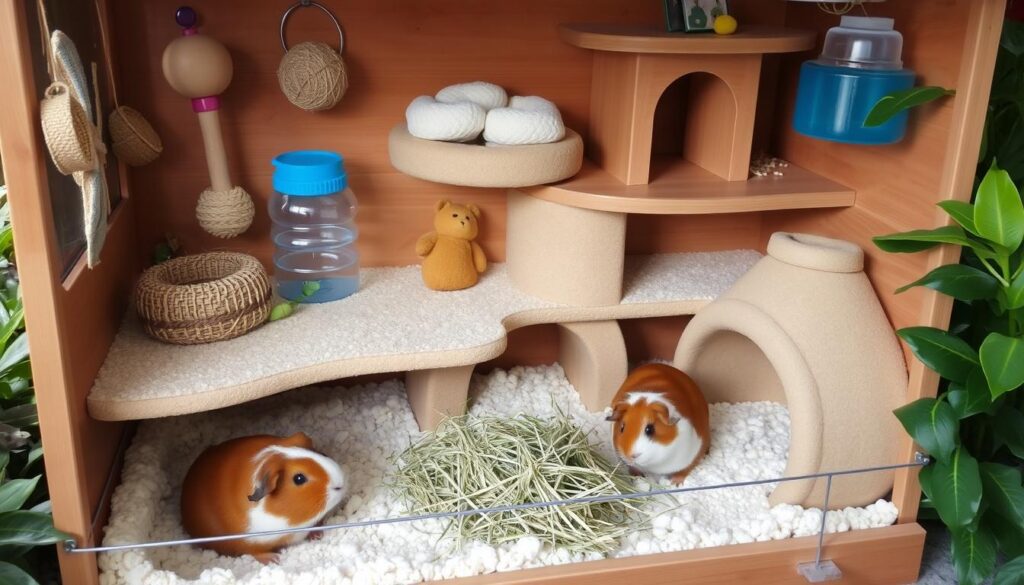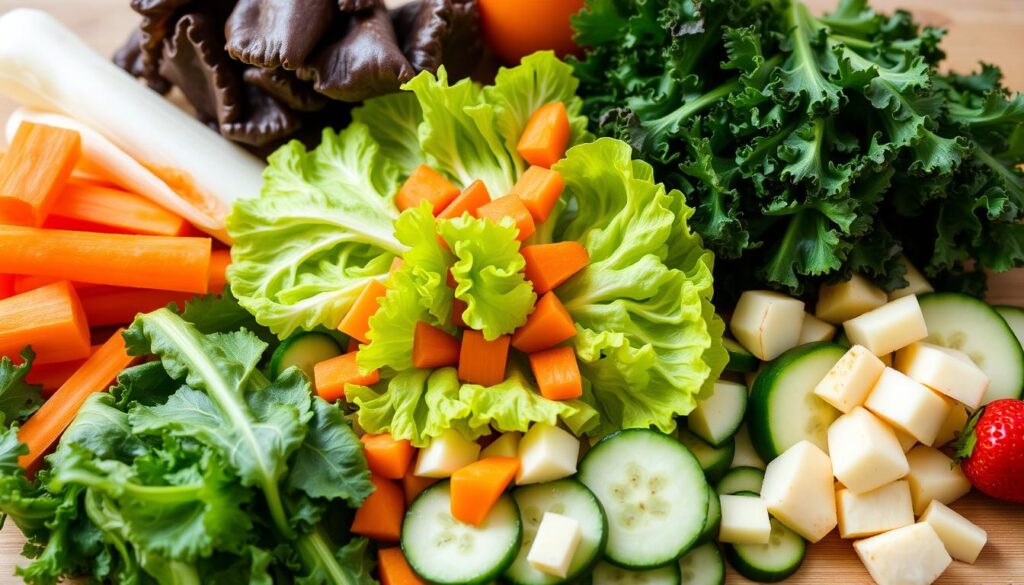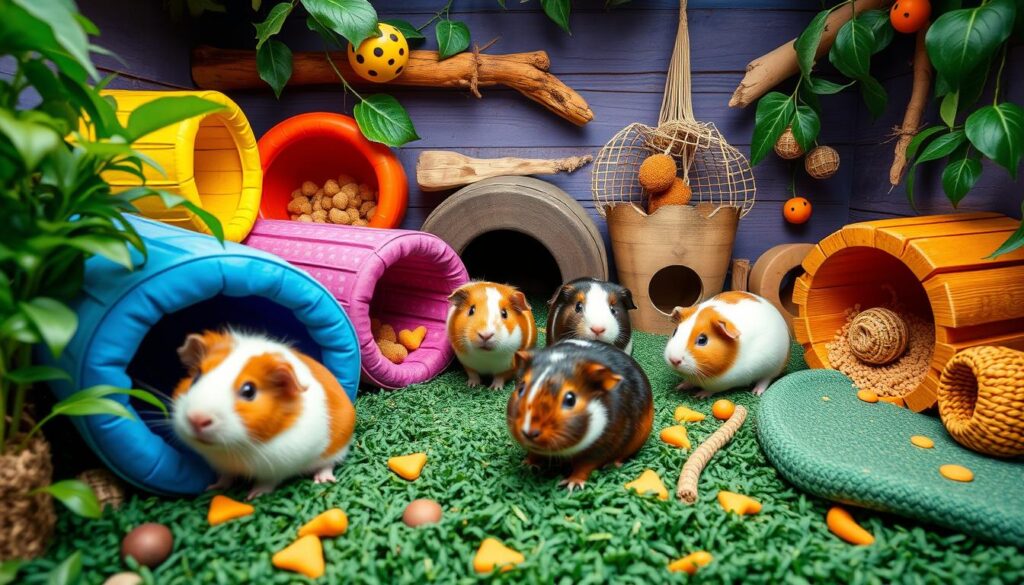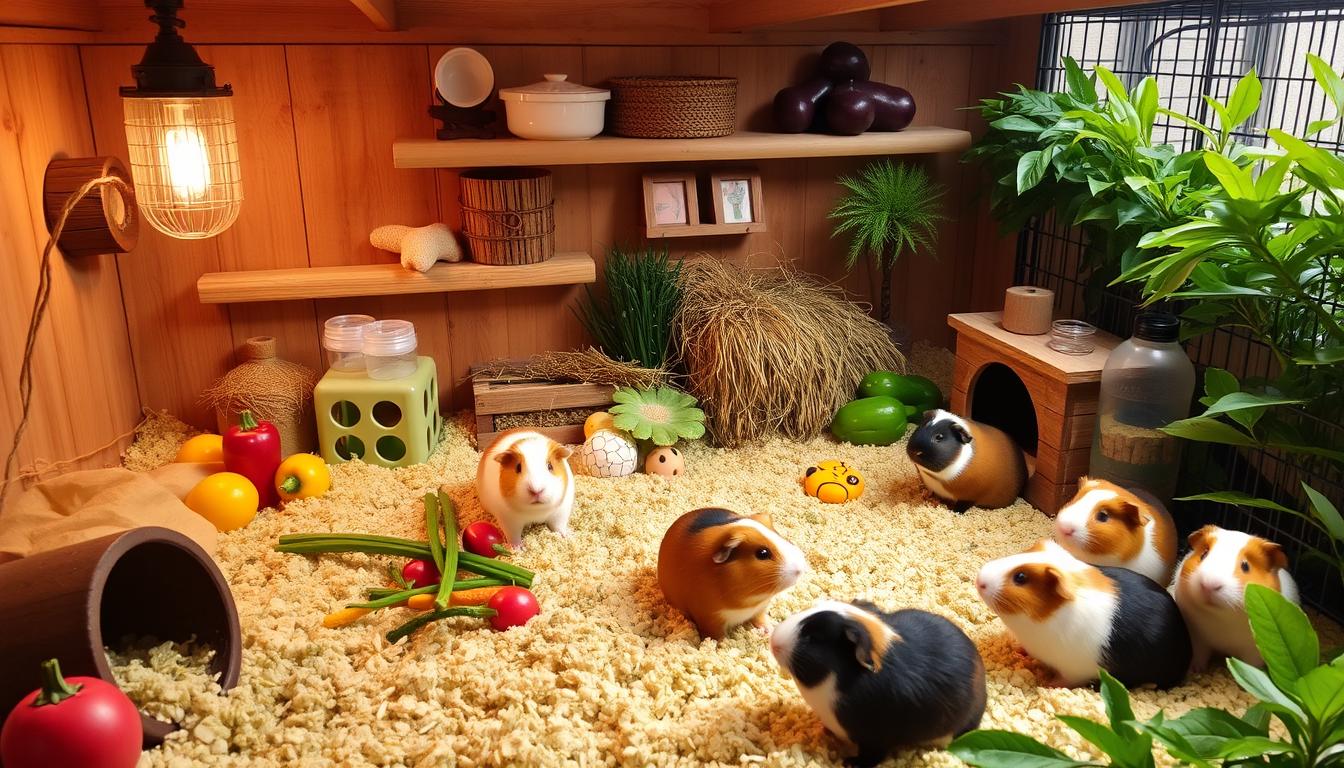Guinea pig care is key to their happiness and health. Knowing their needs is crucial. This includes housing, diet, health, and social needs.
Good care means a happy and healthy guinea pig. You need to create a good home, feed them right, and look after their health and social needs. This way, your guinea pig can live a long, joyful life.
Guinea pig care is more than just the basics. It’s about creating a loving space that meets their physical and emotional needs. By focusing on their care, you can strengthen your bond and help them have a fulfilling life.
Key Takeaways
- Guinea pig care essentials include housing, diet, health, and social needs
- Providing a suitable environment is crucial for your pet’s happiness and health
- A balanced diet is essential for your guinea pig’s well-being
- Regular health checks are vital for preventing and detecting health issues
- Guinea pig care essentials require attention to their social needs, including interaction and play
- By prioritizing guinea pig care essentials, you can build a strong bond with your pet
Understanding Guinea Pig Care Essentials
Guinea pig care is about creating a good home, feeding them right, and keeping them healthy. As a caring owner, knowing the basics is key. This includes daily tasks and long-term care. Also, following health tips is vital to avoid common problems and keep your pet in top shape.
Basic Care Requirements
First, you need a big cage, a balanced diet, fresh water, and clean the cage often. A guinea pig’s food should be high-quality hay, some pellets, and fresh veggies and fruits. Remember, they need exercise and social time to stay happy and healthy.
What to Expect as a New Owner
Being a new owner means spending time and money on your guinea pig. You’ll need to set up their cage, buy food and accessories. You’ll also need to clean, feed, and play with them regularly. Plus, watching for illness signs and vet visits are important for their health.
Time and Financial Commitments
Time spent on guinea pig care can be a lot, at least 30 minutes a day. The cost can vary too, but expect to spend on the initial setup, food, and vet visits. Remember, health issues can add to the expenses.
- Initial setup: $100-$300
- Monthly food and accessories: $50-$100
- Veterinary check-ups: $50-$100 per visit
Creating the Perfect Guinea Pig Habitat
Guinea pigs need a big and cozy place to live. A good home lets them run, play, and hide. It also keeps their minds busy. Here are some key things to think about:
- Cage size: A minimum of 7.5 square feet of floor space per guinea pig is recommended.
- Layout: Include hiding places, tunnels, and toys to keep your guinea pigs entertained and engaged.
- Accessories: Provide food dishes, water bottles, and bedding that are safe and easy to clean.
For more information on creating the perfect guinea pig environment, visit
By following these tips, you can make a happy and healthy home for your guinea pigs. Remember to learn about their special needs to give them the best care.
Essential Housing Requirements
Guinea pigs need a good home to stay healthy and happy. The size of their cage is key. Aim for at least 7.5 square feet per guinea pig. But, bigger cages are always better.
Choosing the right bedding is also important. You can pick from wood shavings, hay, or special bedding. Each has its own benefits and risks. For example, pine or cedar shavings are bad because they can harm guinea pigs. Instead, aspen shavings or recycled paper are safer.

Cage Size Guidelines
- Minimum of 7.5 square feet per guinea pig
- Larger cages provide more space for movement and play
- Bar spacing should be no more than 1 inch to prevent escape
Bedding Options
It’s crucial to pick the right bedding for a clean and healthy home. The bedding should be deep for burrowing. Clean and replace it every week to avoid bacteria and odors.
| Bedding Material | Pros | Cons |
|---|---|---|
| Aspen Shavings | Comfortable, absorbent | Can be expensive |
| Recycled Paper | Eco-friendly, soft | May not control odor well |
Daily Feeding Guidelines
A proper guinea pig diet is key to your pet’s health. They need a balanced diet that fits their nutritional needs. A good diet includes high-quality pellets, hay, and fresh veggies.
Pellets should be about 1/4 cup per guinea pig daily. Hay should always be available. This helps keep them healthy.
Offering a variety of fresh veggies is best. Safe options include kale, spinach, carrots, and bell peppers. Start with small amounts to avoid upset stomachs. Also, include some fresh fruit like berries and apples.
But, some foods are bad for guinea pigs. Avoid foods high in sugar, fat, and salt. Also, steer clear of foods that can cause choking or blockages. A proper guinea pig diet ensures your pet stays healthy and happy.
Here’s a daily feeding guide:
- 1/4 cup of high-quality pellets per guinea pig per day
- Unlimited hay
- 1-2 cups of fresh vegetables per guinea pig per day
- Limited amounts of fresh fruit
Always provide fresh water. Clean food and water dishes daily to stop bacteria. Following these tips helps keep your guinea pig healthy and happy.
The Importance of Hay and Fresh Water
A good diet for guinea pigs includes high-quality hay, fresh water, and a mix of veggies and fruits. Hay is key for their dental health, digestion, and fiber needs. Timothy hay is best for guinea pigs because it’s full of fiber and low in protein.
It’s also important to keep their water fresh. A water bottle with a sipper tube is a good choice. It stops spills and keeps the water clean. For more pet care tips, check out pet care websites.
Types of Hay to Offer
When picking hay for your guinea pig, consider these options:
- Timothy hay: high in fiber, low in protein
- Alfalfa hay: high in protein, rich in calcium
- Orchard grass hay: a mix of grasses, high in fiber
Offering different types of hay is important for a balanced diet. Make sure your guinea pig always has fresh water. A diet rich in hay, veggies, and fruits will keep them happy and healthy.
Fresh Vegetables and Fruits in Their Diet
A proper guinea pig diet must include fresh veggies and fruits for nutrients. Start new foods slowly to avoid upset stomachs. Introduce one new food at a time, in small amounts, and watch how your guinea pig reacts.
Some safe and nutritious options for guinea pigs include:
- Leafy greens like kale, spinach, and lettuce
- Crunchy vegetables like carrots, bell peppers, and cucumbers
- Fresh fruits like strawberries, blueberries, and apples
Always wash veggies and fruits well before giving them to your guinea pig. Remove any harmful seeds, pits, or stems. A proper guinea pig diet also needs hay, pellets, and fresh water for health.

Adding different veggies and fruits to your guinea pig’s diet keeps meals fun and nutritious. But, don’t overfeed. Keep a balance between treats and main foods. By following these tips, you can help your guinea pig live a happy and healthy life.
Essential Vitamin C Supplementation
Guinea pig health tips stress the need for Vitamin C in their diet. They can’t make it on their own. Without it, they risk getting scurvy, a serious disease. So, it’s key to feed them a diet full of Vitamin C.
Oranges, strawberries, and bell peppers are good natural sources of Vitamin C. Adding them in small amounts helps meet their Vitamin C needs. But, it’s also wise to use supplements like liquid drops or tablets to make sure they get enough.
Natural Sources of Vitamin C
- Oranges
- Strawberries
- Bell peppers
- Kale
- Broccoli
When picking supplements, make sure to follow the daily amounts. The Vitamin C needs of guinea pigs change with age, health, and if they’re pregnant. Talking to a vet can help figure out the right amount for your guinea pig.
Supplement Options
There are many supplement choices, like liquid drops and tablets. You can mix them into their food or water. This makes it easy to keep them healthy with enough Vitamin C. By following these tips, you can keep your guinea pig happy and healthy.
| Age | Daily Vitamin C Requirements |
|---|---|
| Young guinea pigs | 10-20 mg |
| Adult guinea pigs | 5-10 mg |
| Pregnant guinea pigs | 20-30 mg |
Proper Grooming Techniques
Guinea pig grooming is key to keeping them healthy and clean. It prevents their fur from matting and tangling, especially for long-haired ones. Brush them gently but thoroughly, being careful not to hurt their skin.
Trimming their nails needs the right tools and care to avoid stress or pain. Guinea pig grooming techniques also include checking for infections or diseases. This way, you can keep your pet in top condition.
Here are some important grooming tips for guinea pigs:
- Brushing: Use a soft-bristled brush or a slicker brush for long-haired guinea pigs
- Nail trimming: Use a guinea pig nail clipper or a human nail clipper with caution
- Bathing: Only bathe your guinea pig when necessary, using a mild shampoo and lukewarm water
- Dental care: Check your guinea pig’s teeth regularly for signs of wear or misalignment
By following these grooming tips, you can ensure your guinea pig stays happy and healthy. Always handle them gently and seek vet advice if you have health concerns.
| Grooming Task | Frequency | Importance |
|---|---|---|
| Brushing | Daily | High |
| Nail trimming | Weekly | Medium |
| Bathing | As needed | Low |
Exercise and Enrichment Activities
Guinea pigs need fun activities to stay healthy and happy. They should get regular exercise to avoid getting too fat. It’s important to make their living space fun and safe.
Guinea pigs love different toys and games. You can give them tunnels, balls, and chew toys. You can also make your own toys from things like cardboard rolls and paper bags. Changing toys often keeps them excited and stops boredom.
Safe Play Areas
When setting up play areas, think about keeping your guinea pig safe. Here are some tips:
- Make sure the play area is big and safe
- Choose toys and materials that are safe for guinea pigs
- Always watch them during playtime to avoid accidents

Toy Recommendations
Here are some toys that are great for guinea pigs:
- Tunnels and tents for them to hide and play
- Balls and other toys that roll for fun exercise
- Chew toys, like wood or hay, for their teeth
By giving your guinea pig fun activities and a lively space, you can keep them happy and healthy.
| Toy Type | Benefits |
|---|---|
| Tunnels and Tents | Provide hiding places, reduce stress |
| Balls and Rolling Toys | Encourage exercise, improve cardiovascular health |
| Chew Toys | Promote dental health, reduce boredom |
Health Monitoring and Common Issues
Regular health checks are key to spotting common guinea pig illnesses early. Owners should check their guinea pig’s eyes, ears, nose, teeth, and skin for any signs of infection or disease. Issues like respiratory infections, dental problems, and skin conditions are common.
Knowing the symptoms of these common guinea pig illnesses is crucial. Respiratory infections can cause wheezing, sneezing, and runny eyes. Dental problems can lead to overgrown teeth, drooling, and loss of appetite. Skin conditions, like mites or fungal infections, can cause itching, hair loss, and skin lesions.
To prevent these health issues, owners should keep their guinea pig’s environment clean. They should also provide a balanced diet and ensure regular vet visits. Here are some preventive care measures to consider:
- Clean the cage regularly to prevent the buildup of bacteria and germs
- Provide a balanced diet that includes high-quality hay, fresh vegetables, and limited amounts of pellets
- Ensure access to fresh water at all times
- Schedule regular veterinary check-ups to monitor health and detect any potential issues early on
By knowing the common health issues and taking preventive steps, owners can help their guinea pigs live long, healthy lives. Regular health monitoring and prompt vet care are vital for their well-being.
Bonding With Your Guinea Pig
Building a strong bond with your guinea pig is key for its happiness. By learning about guinea pig behavior, you can make a safe and loving space. Start by moving calmly and gently around your guinea pig. This lets it get used to you and your voice.
Learning how to handle your guinea pig is important. Begin by letting it get comfortable with your hands. Then, slowly teach it to enjoy being scooped and lifted. Always support its body and lift it gently to keep it safe. Pay attention to how your guinea pig acts, like its sounds and movements. This helps you understand what it needs and feels.
- Relaxed posture: a guinea pig that feels comfortable and secure will stand upright with its ears perked up and its fur smooth.
- Alertness: a guinea pig that is alert and engaged will respond to its surroundings, such as reacting to sounds or movements.
- Stress or fear: a guinea pig that is stressed or fearful may exhibit signs such as trembling, hiding, or making high-pitched squeaks.
By noticing these signs and acting on them, you can grow closer to your guinea pig. Always handle it gently and keep its environment interesting. This way, you meet its physical and emotional needs.
Seasonal Care Considerations
As a responsible guinea pig owner, it’s important to think about the changing seasons. These changes can affect your pet’s care. You need to adjust their environment to keep them comfortable all year.
In winter, keeping drafts out and the temperature warm is key. You might need to add more bedding or use heat sources.
In summer, it’s crucial to prevent your guinea pig from getting too hot. Make sure they have plenty of fresh water. Using cooling mats or wet towels can also help keep them cool.
Adding seasonal vegetables and fruits to their diet can also be good for their health.
Some important seasonal care tips include:
- Providing extra bedding in the winter to keep your guinea pig warm
- Ensuring adequate ventilation in the summer to prevent overheating
- Incorporating seasonal vegetables and fruits into their diet
- Managing outdoor time safely in different weather conditions
By keeping these seasonal care tips in mind, you can help your guinea pig stay happy and healthy all year.
| Season | Care Considerations |
|---|---|
| Winter | Prevent drafts, maintain warm temperature, provide extra bedding |
| Summer | Prevent overheating, ensure adequate hydration, provide cooling mats or wet towels |
Travel and Emergency Preparedness
Traveling with your guinea pig or preparing for emergencies requires the right knowledge and equipment. This is key for their health and well-being. Being ready for any situation is important, whether at home or on the go.
Travel Carriers and Emergency Kit Essentials
A good travel carrier should be secure, comfy, and well-ventilated. Your emergency kit should have first aid supplies, critical care formula, and important documents. Here are some must-haves for the kit:
- Food and water for at least 3 days
- A first aid kit with bandages and antiseptic wipes
- A list of emergency contact numbers, including a vet
Guinea pig health tips also stress the need to find a vet who knows about exotic pets. You can search online or ask other guinea pig owners for recommendations.
Finding a Qualified Vet and Preparing for Emergencies
Being ready for emergencies and finding a good vet are crucial for your guinea pig’s health. By following these tips and being prepared, you can keep your pet safe and healthy, even in unexpected situations.
| Emergency Situation | Response |
|---|---|
| Loss of power or heat | Move your guinea pig to a safe, warm location |
| Natural disaster | Evacuate with your guinea pig, if possible, and have an emergency kit ready |
Long-term Care Planning
Guinea pigs can live up to 8 years or more with the right care. It’s key to plan for their long-term needs. This means thinking about changes in their diet, home, and exercise as they age.
Regular health check-ups are crucial for your guinea pig’s long-term care. These visits help catch health issues early, like arthritis or dental problems. This way, you can take action quickly to help your pet.
Don’t forget the financial side of long-term care. Costs for food, bedding, and vet visits add up. It’s smart to budget for these and plan for medical expenses. Pet insurance can also help with unexpected vet bills.
- Providing a comfortable and safe living environment
- Ensuring access to regular veterinary care
- Planning for potential age-related health issues
- Budgeting for ongoing expenses and potential medical costs
Planning ahead for your guinea pig’s care ensures they live a happy life. Keep up with the latest care tips and adjust as needed. This way, you meet your pet’s changing needs.
Conclusion: Creating a Happy Life for Your Guinea Pig
Learning how to care for your guinea pig is key to their happiness and health. This guide has shown you the guinea pig care essentials. Now, you can make a loving home for your furry friend.
Keeping their home clean and comfy is important. Also, feeding them well and giving them fun activities is crucial. Remember, guinea pigs love to be around people and enjoy playing together.
Looking after a guinea pig can be very rewarding. Keep learning and adjusting to your pet’s needs. This way, your guinea pig will live a happy, healthy life with you. With the right care, you’ll have a lifelong friend that brings joy to your home.
FAQ
What are the basic care requirements for guinea pigs?
Guinea pigs need a big, airy home and a diet of hay, pellets, and veggies. They also need regular grooming and places to play. Keeping their home clean, feeding them right, and taking them to the vet are key to their health.
What should I expect as a new guinea pig owner?
Owning a guinea pig means a big commitment of time and money. You’ll need to care for them every day and spend on their home and food. Remember, there are ongoing costs for their care and vet visits.
What are the essential housing requirements for guinea pigs?
Guinea pigs need a big, airy cage to move around and play. A single guinea pig needs at least 7.5 square feet of space. Their cage should have good bedding, hiding spots, and toys to keep them happy.
What should a guinea pig’s diet consist of?
A guinea pig’s diet should be mostly hay for their teeth and digestion. Add some pellets and fresh veggies. Always have fresh water ready, and remember to give them Vitamin C since they can’t make it themselves.
How do I properly groom a guinea pig?
Grooming keeps guinea pigs healthy and clean. Brush them a few times a week to remove loose hair. Trim their nails every 4-6 weeks. Bathe them only when really needed to keep them clean.
What types of enrichment activities should I provide for my guinea pig?
Guinea pigs need to exercise and have fun. Give them safe places to play and toys to explore. Spending time with them is also a great way to enrich their lives.
How can I monitor my guinea pig’s health and recognize common issues?
Check your guinea pig’s health at home by looking at their eyes, ears, and skin. Watch for signs of illness like breathing problems or dental issues. Knowing when to see a vet is important for their health.
How do I build a bond with my guinea pig?
Building a bond with your guinea pig takes time and patience. Move calmly around them and use positive rewards. Understanding their body language and sounds helps you care for them better.

